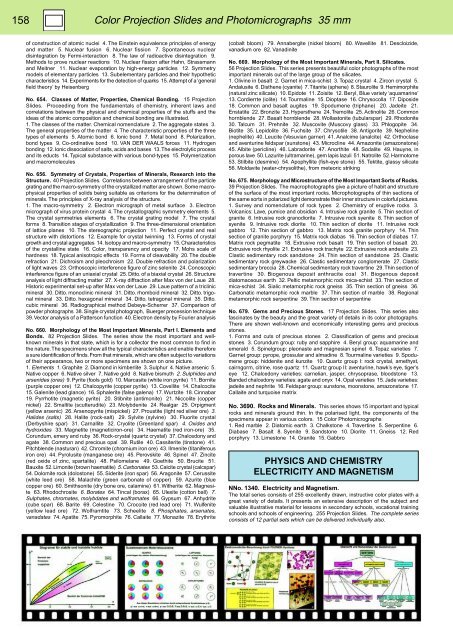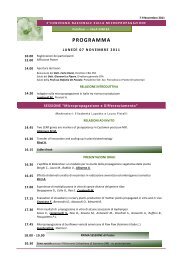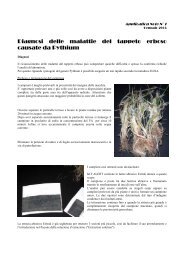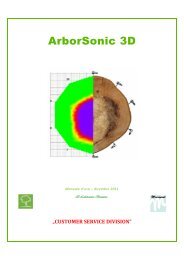BIOLOGY - microscopia.info
BIOLOGY - microscopia.info
BIOLOGY - microscopia.info
You also want an ePaper? Increase the reach of your titles
YUMPU automatically turns print PDFs into web optimized ePapers that Google loves.
158<br />
Color Projection Slides and Photomicrographs 35 mm<br />
of construction of atomic nuclei 4. The Einstein equivalence principles of energy<br />
and matter 5. Nuclear fusion 6. Nuclear fission 7. Spontaneous nuclear<br />
disintegration by Fermi-interaction 8. The law of radioactive disintegration 9.<br />
Methods to prove nuclear reactions 10. Nuclear fission after Hahn, Strassmann<br />
and Meitner 11. Nuclear evaporation by high-energy particles 12. Symmetry<br />
models of elementary particles 13. Subelementary particles and their hypothetic<br />
characteristics 14. Experiments for the detection of quarks 15. Attempt of a ‘general<br />
field theory’ by Heisenberg<br />
No. 654. Classes of Matter, Properties, Chemical Bonding. 15 Projection<br />
Slides. Proceeding from the fundamentals of chemistry, inherent laws and<br />
correlations between the physical and chemical properties of the stuffs and the<br />
ideas of the atomic composition and chemical bonding are illustrated.<br />
1. The classes of the matter. Chemical nomenclature 2. The aggregate states 3.<br />
The general properties of the matter 4. The characteristic properties of the three<br />
types of elements 5. Atomic bond 6. Ionic bond 7. Metal bond 8. Polarization,<br />
bond types 9. Co-ordinative bond 10. VAN DER WAALS forces 11. Hydrogen<br />
bonding 12. Ionic dissociation of salts, acids and bases 13. The electrolytic process<br />
and its educts 14. Typical substance with various bond-types 15. Polymerization<br />
and macromolecules<br />
No. 656. Symmetry of Crystals, Properties of Minerals, Research into the<br />
Structure. 40 Projection Slides. Correlations between arrangement of the particle<br />
grating and the macro-symmetry of the crystallized matter are shown. Some macrophysical<br />
properties of solids being suitable as criterions for the determination of<br />
minerals. The principles of X-ray analysis of the structure.<br />
1. The macro-symmetry 2. Electron micrograph of metal surface 3. Electron<br />
micrograph of virus protein crystal 4. The crystallographic symmetry elements 5.<br />
The crystal symmetries elements 6. The crystal grating model 7. The crystal<br />
forms 8. Transition stages of crystallization 9. The three-dimensional orientation<br />
of lattice planes 10. The stereographic projection 11. Perfect crystal and real<br />
structure with distortions 12. Example for crystal twinning 13. Forms of crystal<br />
growth and crystal aggregates 14. Isotopy and macro-symmetry 15. Characteristics<br />
of the crystalline state 16. Color, transparency and opacity 17. Mohs scale of<br />
hardness 18. Typical anisotropic effects 19. Forms of cleavability 20. The double<br />
refraction 21. Dichroism and pleochroism 22. Double refraction and polarization<br />
of light waves 23. Orthoscopic interference figure of zinc selenite 24. Conoscopic<br />
interference figure of an uniaxial crystal 25. Ditto. of a biaxial crystal 26. Structure<br />
analysis of light diffracting matter 27. X-ray diffraction after Max von der Laue 28.<br />
Historic experimental set-up after Max von der Laue 29. Laue pattern of a triclinic<br />
mineral 30. Ditto. monoclinic mineral 31. Ditto. rhomboid mineral 32. Ditto. trigonal<br />
mineral 33. Ditto. hexagonal mineral 34. Ditto. tetragonal mineral 35. Ditto.<br />
cubic mineral 36. Radiographical method Debeye-Scherrer 37. Comparison of<br />
powder photographs 38. Single crystal photograph, Buerger precession technique<br />
39. Vector analysis of a Patterson function 40. Electron density by Fourier analysis<br />
No. 660. Morphology of the Most Important Minerals, Part I. Elements and<br />
Bonds. 82 Projection Slides. The series show the most important and wellknown<br />
minerals in that state, which is for a collector the most common to find in<br />
the nature. The specimens show all the typical characteristics and enable therefore<br />
a sure identification of finds. From that minerals, which are often subject to variations<br />
of their appearance, two or more specimens are shown on one picture.<br />
1. Elements 1. Graphite 2. Diamond in kimberlite 3. Sulphur 4. Native arsenic 5.<br />
Native copper 6. Native silver 7. Native gold 8. Native bismuth 2. Sulphides and<br />
arsenides (ores) 9. Pyrite (fools gold) 10. Marcasite (white iron pyrite) 11. Bornite<br />
(purple copper ore) 12. Chalcopyrite (copper pyrite) 13. Covellite 14. Chalcocite<br />
15. Galenite (lead glance) 16. Sphalerite (false galena) 17. Wurtzite 18. Cinnabar<br />
19. Pyrrhotite (magnetic pyrite) 20. Stibnite (antimonite) 21. Niccolite (copper<br />
nickel) 22. Smaltite (scutterudite) 23. Molybdenite 24. Realgar 25. Orpigment<br />
(yellow arsenic) 26. Arsenopyrite (mispickel) 27. Proustite (light red silver ore) 3.<br />
Halides (salts) 28. Halite (rock-salt) 29. Sylvite (sylvine) 30. Fluorite crystal<br />
(Derbyshire spar) 31. Carnallite 32. Cryolite (Greenland spar) 4. Oxides and<br />
hydroxides 33. Magnetite (magneticiron-ore) 34. Haematite (red iron-ore) 35.<br />
Corundum, emery and ruby 36. Rock-crystal (quartz crystal) 37. Chalcedony and<br />
agate 38. Common and precious opal 39. Rutile 40. Cassiterite (tinstone) 41.<br />
Pitchblende (nasturan) 42. Chromite (chromium iron ore) 43. Ilmenite (titaniferous<br />
iron ore) 44. Pyrolusite (manganese ore) 45. Perovskite 46. Spinel 47. Zincite<br />
(red oxide of zinc, spartalite) 48. Psilomelane 49. Goethite 50. Brucite 51.<br />
Bauxite 52. Limonite (brown haematite) 5. Carbonates 53. Calcite crystal (calcspar)<br />
54. Dolomite rock (dolostone) 55. Siderite (iron spar) 56. Aragonite 57. Cerussite<br />
(white leed ore) 58. Malachite (green carbonate of copper) 59. Azurite (blue<br />
copper ore) 60. Smithsonite (dry bone ore, calamine) 61. Witherite 62. Magnesite<br />
63. Rhodochrosite 6. Borates 64. Tincal (borax) 65. Ulexite (cotton ball) 7.<br />
Sulphates, chromates, molybdates and wolframates 66. Gypsum 67. Anhydrite<br />
(cube spar) 68. Barite 69. Celestine 70. Crocoite (red lead ore) 71. Wulfenite<br />
(yellow lead ore) 72. Wolframtite 73. Scheelite 8. Phosphates, arsenates,<br />
vanadates 74. Apatite 75. Pyromorphite 76. Callaite 77. Monazite 78. Erythrite<br />
(cobalt bloom) 79. Annabergite (nickel bloom) 80. Wavellite 81. Descloizide,<br />
vanadium ore 82. Vanadinite<br />
No. 669. Morphology of the Most Important Minerals, Part II. Silicates.<br />
56 Projection Slides. This series presents beautiful color photographs of the most<br />
important minerals out of the large group of the silicates.<br />
1. Olivine in basalt 2. Garnet in mica-schist 3. Topaz crystal 4. Zircon crystal 5.<br />
Andalusite 6. Disthene (cyanite) 7. Titanite (sphene) 8. Staurolite 9. Hemimorphite<br />
(natural zinc silicate) 10. Epidote 11. Zoisite 12. Beryl, Blue variety ‘aquamarine’<br />
13. Cordierrte (iolite) 14. Tourmaline 15. Dioptase 16. Chrysocolla 17. Diposide<br />
18. Common and basalt augites 19. Spodumene (triphane) 20. Jadeite 21.<br />
Enstatite 22. Bronzite 23. Hypersthene 24. Tremolite 25. Actinolite 26. Common<br />
hornblende 27. Basalt hornblende 28. Wollastonite (tubularspar) 29. Rhodonite<br />
30. Talcum 31. Prehnite 32. Muscovite (Muscovy glass) 33. Phlogopite 34.<br />
Biotite 35. Lepidolite 36. Fuchsite 37. Chrysotile 38. Antigorite 39. Nepheline<br />
(nephelite) 40. Leucite (Vesuvian garner) 41. Analcime (analcite) 42. Orthoclase<br />
and aventurine feldspar (sunstone) 43. Microcline 44. Amazonite (amazonstone)<br />
45. Albite (pericline) 46. Labradorite 47. Anorthite 48. Sodalite 49. Hauyne, in<br />
porous lave 50. Lazurite (ultramarine), gem lapis lazuli 51. Natrolite 52. Harmotome<br />
53. Stilbite (desmine) 54. Apophyllite (fish-eye stone) 55. Tektite, glassy silicate<br />
56. Moldavite (water-chrysolithe), from meteoric striking<br />
No. 675. Morphology and Microstructure of the Most Important Sorts of Rocks.<br />
39 Projection Slides. The macrophotographs give a picture of habit and structure<br />
of the surface of the most important rocks. Microphotographs of thin sections of<br />
the same sorts in polarized light demonstrate their inner structure in colorful pictures.<br />
1. Survey and nomenclature of rock types 2. Chemistry of eruptive rocks 3.<br />
Volcanics: Lave, pumice and obsidian 4. Intrusive rock granite 5. Thin section of<br />
granite 6. Intrusive rock granodiorite 7. Intrusive rock syenite 8. Thin section of<br />
syenite 9. Intrusive rock diorite 10. Thin section of diorite 11. Intrusive rock<br />
gabbro 12. Thin section of gabbro 13. Matrix rock granite porphyry 14. Thin<br />
section of granite porphyry 15. Matrix rock diabas 16. Thin section of diabas 17.<br />
Matrix rock pegmatite 18. Extrusive rock basalt 19. Thin section of basalt 20.<br />
Extrusive rock rhyolite 21. Extrusive rock trachyte 22. Extrusive rock andesite 23.<br />
Clastic sedimentary rock sandstone 24. Thin section of sandstone 25. Clastic<br />
sedimentary rock greywacke 26. Clastic sedimentary conglomerate 27. Clastic<br />
sedimentary breccia 28. Chemical sedimentary rock travertine 29. Thin section of<br />
travertine 30. Biogenous deposit anthracite coal 31. Biogenous deposit<br />
diatomaceous earth 32. Peltic metamorphic rock mica-schist 33. Thin section of<br />
mica-schist 34. Sialic metamorphic rock gneiss 35. Thin section of gneiss 36.<br />
Carbonatic metamorphic rock marble 37. Thin section of marble 38. Regional<br />
metamorphic rock serpentine 39. Thin section of serpentine<br />
No. 679. Gems and Precious Stones. 17 Projection Slides. This series also<br />
fascinates by the beauty and the great variety of details in its color photographs.<br />
There are shown well-known and economically interesting gems and precious<br />
stones.<br />
1. Forms and cuts of precious stones 2. Classification of gems and precious<br />
stones 3. Corundum group: ruby and sapphire 4. Beryl group: aquamarine and<br />
emerald 5. Spinelgroup: pleonaste and magnesian spinel 6. Topaz varieties 7.<br />
Garnet group: pyrope, grossular and almadine 8. Tourmaline varieties 9. Spodumene<br />
group: hiddenite and kunzite 10. Quartz group I: rock crystal, amethyst,<br />
cairngorm, citrine, rose quartz 11. Quartz group II: aventurine, hawk’s eye, tiger’s<br />
eye 12. Chalcedony varieties: carnelian, jasper, chrysoprase, bloodstone 13.<br />
Banded chalcedony varieties: agate and onyx 14. Opal varieties 15. Jade varieties:<br />
jadeite and nephrite 16. Feldspar group: sunstone, moonstone, amazonstone 17.<br />
Callaite and turquoise matrix<br />
No. 3690. Rocks and Minerals. This series shows 15 important and typical<br />
rocks and minerals ground thin. In the polarised light, the components of the<br />
specimens appear in various colors. 15 Color Photomicrographs<br />
1. Red marble 2. Diatomic earth 3. Chalkstone 4. Travertine 5. Serpentine 6.<br />
Diabase 7. Basalt 8. Syenite 9. Sandstone 10. Diorite 11. Gneiss 12. Red<br />
porphyry 13. Limestone 14. Granite 15. Gabbro<br />
PHYSICS AND CHEMISTRY<br />
ELECTRICITY AND MAGNETISM<br />
NNo. 1340. Electricity and Magnetism.<br />
The total series consists of 255 excellently drawn, instructive color plates with a<br />
great variety of details. It presents an extensive description of the subject and<br />
valuable illustrative material for lessons in secondary schools, vocational training<br />
schools and schools of engineering. 255 Projection Slides. The complete series<br />
consists of 12 partial sets which can be delivered individually also.<br />
No. 1341. Identifying Quantities in a Direct-Current Field. 25 Projection Slides







